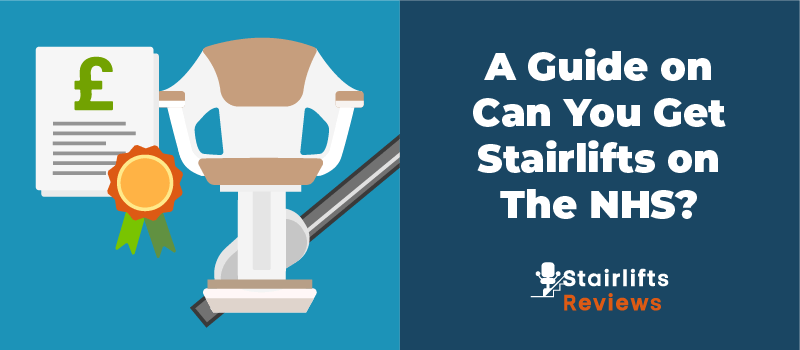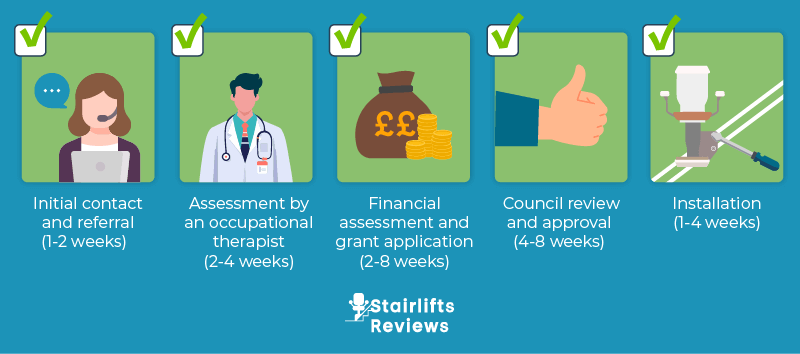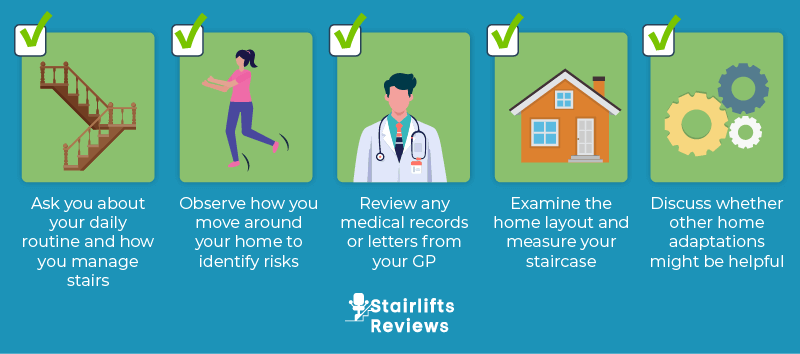Can You Get a Stairlift from the NHS in the UK? 2025

- You cannot directly get a stairlift from the National Health Service (NHS), but it helps you with the health assessment process.
- You can contact your local GP or social services to start your process as they can help you with an assessment by an occupational therapist.
- During this assessment, you will be evaluated based on your mobility needs, home layout, and safety risks that will determine if a stairlift is required.
- The maximum amount from Disabled Facilities Grant (DFG) is £30,000 in England, £36,000 in Wales, and £25,000 in Northern Ireland. This process from initial assessment to installation can take between 3-18 months.
Struggling to get up and down stairs at home can feel like a daily battle, but there is help available. While the NHS doesn’t hand out stairlifts directly, it plays a key role in assessing your needs and pointing you towards funding options available in the UK. This includes stairlifts grants like the Disabled Facilities Grant (DFG) which can help reduce your overall expenses.
In this step-by-step guide, we’ll unravel the process, showing you how to turn those tricky steps into a smooth ride, helping you stay safe, independent, and comfortable in your own home.
Finding a trustworthy stairlift expert on your own can drag on for days. It is much easier to find one with our help. Simply fill out a 30-second form, and we’ll connect you with up to 4 vetted stairlift installers. You can then compare their quotes with no obligation, making the process quick and easy.
Click below to get started!
Contents
Can you get a stairlift on the NHS?
How do you get a stairlift on the NHS?
What does the assessment from the NHS look like?
How to get the right stairlift?
Can you get a stairlift on the NHS in the UK?
You cannot get a stairlift directly from the NHS in the UK. The NHS does not supply or fund stairlifts itself, but it plays a key role in the process by providing an assessment of your needs through an occupational therapist. If the assessment shows you have severe mobility issues that make using stairs unsafe or difficult, you may be eligible for support, as a stairlift is essential for your independence.

You qualify for a stairlift grant if you pass the assessment by the occupational therapist. The eligibility is based on the following:
Physical, neurological, cognitive conditions
Having a medical condition or disability that makes stairs dangerous or hard to use, that impact daily movement like:
- Arthritis or joint conditions affecting mobility
- Heart problems that limit physical exertion
- Respiratory issues that cause breathing difficulties when climbing stairs
- Long-term physical disabilities affecting mobility
- Age-related mobility decline
It could also include neurological or cognitive conditions like:
- Learning disabilities that affect safe stair navigation
- Autism with associated mobility or safety concerns
- Cognitive impairments such as dementia
- Progressive conditions like motor neurone disease
- Terminal illnesses that impact mobility
- Mental health conditions that affect ability to use stairs safely
Home conditions and technical requirements
Your home must be suitable for stairlift installation. Key factors include:
- Stair configuration: Stairlifts can be fitted to most stairs, but feasibility of installation varies by the type of staircase you have. Straight stairs require a minimum width of approximately 28 inches (71cm) while the curved or L-shaped stairs require a minimum width of about 30 inches (76cm). The stairlift must also have access to a 13A 240V power outlet near the stairs.
- User capability assessment: The person using the stairlift must be able to sit safely during transit. They must be able to transfer independently (or with minimal assistance) on and off the stairlift at both ends of the stairs, If you use walking aids such as frames, you’ll need separate aids at the top and bottom of stairs as they cannot be carried on the stairlift.
Financial eligibility factors
Since stairlifts are primarily funded through the Disabled Facilities Grant (DFG), financial assessment is part of the process. The DFG is means-tested based on household income and savings. Having savings over £6,000 can significantly reduce chances of grant approval.
With the exception that the savings limit doesn’t apply when applying for a family member under 19 years old. Also, the receipt of certain benefits like Universal Credit, Income Support and many more may automatically qualify you financially for the DFG without further means testing.
The process involves an initial referral, a home assessment, a financial check, and, if everything is approved, the council will arrange the stairlift installation. The whole process can take several weeks to months, so it is best to start early.
How do you get a stairlift on the NHS?

You can’t get a stairlift directly from the NHS, but the NHS helps you start the process and guides you towards local council funding. Here’s how it works, step by step:
Initial contact and referral (1-2 weeks)
Start by contacting your local GP or council’s social services. Explain your mobility difficulties and request a home assessment. They will refer you to an occupational therapist (OT), and you may be placed on a waiting list depending on demand.
Assessment by an occupational therapist (2-4 weeks)
An OT will visit your home to assess your needs and decide if a stairlift is important for your safety and independence. They will also check other possible adaptations. If a stairlift is recommended, the OT will support your case for funding.
Financial assessment and grant application (2-8 weeks)
If a stairlift is recommended, you will undergo a financial assessment to see if you qualify for a Disabled Facilities Grant (DFG) from your local council. The maximum grant amount per applicant is £30,000 in England, up to £36,000 in Wales and up to £25,000 in Northern Ireland.
In Scotland, DFGs are not available, but they have different support systems for equipment and adaptations. The DFG can cover various home adaptations including stairlifts, bathroom modifications, ramps, widened doorways, and more

This grant is means-tested, so you’ll need to provide details about your income, savings, and outgoings. Some people on certain benefits may automatically qualify.
Examples of the qualifying benefits mentioned above include: Income Support, income-based Jobseeker’s Allowance, income-related Employment and Support Allowance, Pension Credit (guarantee credit), Universal Credit, and Housing Benefit. This means that, being on these benefits, you skip the financial assessment and receive the grant in full, as long as the adaptation has been recommended by an occupational therapist and approved by your local council.
If you don’t receive these benefits, your household income and savings will be assessed. Household savings over £6,000 are considered in the means test. Based on the assessment, you may need to put in some money on your own towards the work.
Council review and approval (4-8 weeks)
The council reviews your application, the OT’s recommendation, and your financial details. If they are approved, they will arrange for the stairlift installation. You may need to provide 2 quotes from your stairlift suppliers, and make sure that no work starts before approval.
Installation (1-4 weeks)
Once approved, the council will organise the installation. The whole process, from first contact to installation, can take several months, so it’s best to start early.
In summary, while the NHS doesn’t supply stairlifts, they play a vital role in assessment and guiding you towards council funding. The process involves contacting your GP or council, getting assessed, applying for a grant, and, if approved, having the stairlift fitted.
What does the assessment from the NHS look like?

The NHS assessment for a stairlift is carried out by an occupational therapist (OT) during a home visit. The main aim is to understand your mobility challenges and see if a stairlift is necessary for your safety and independence.
During the assessment, the OT will:
- Ask you about your daily routine and how you currently manage the stairs.
- Observe how you move around your home, especially on the stairs, to identify any risks such as falls, fatigue, or pain.
- Review any medical records or letters from your GP that explain your condition and mobility issues.
- Examine the home layout and measure your staircase to check if a stairlift can be safely installed.
- Discuss whether other home adaptations (like grab rails or ramps) might also be helpful.
The OT’s goal is to recommend the best solution to help you live independently and safely. If a stairlift is essential, their recommendation will help your application for funding through your local council. The assessment is free, and you will be guided by the NHS through the next steps if further action is needed.
How to get the right stairlift?
Finding the right stairlift for your home starts with understanding your staircase and your personal needs. For straight staircases, a straight stairlift is usually the simplest and most cost-effective option. But if your stairs have bends, corners, or landings, you will need a curved stairlift, which is custom-made to fit and generally more expensive.
There are also standing and perch stairlifts for those who struggle to sit, platform lifts for wheelchair users, and outdoor models for steps outside the home. The best way to ensure you’re getting the right stairlift at the best price is to compare quotes from several reputable UK suppliers.
Getting multiple quotes lets you compare stairlift prices, features, warranties, and aftercare services, so you can make an informed decision and avoid overpaying. While this can ordinarily take days of time-consuming research, contacting the best stairlift companies on your own, we can streamline your search and provide you with multiple prices.
All you have to do is fill out a 30-second form and we’ll provide you with up to 4 free, non-binding quotes from reputable stairlift installers in your area. We’ve thoroughly vetted them ourselves so you can be sure they’re up to the task.
Click the button below to get started.
FAQ
How to get a stairlift from social services?
To start the process of getting a stairlift, contact your local council’s social services department or your GP. They will arrange for an occupational therapist to assess your mobility needs at home. If the assessment shows a stairlift is essential for your safety and independence, you may be referred for a Disabled Facilities Grant (DFG) or other local funding. If approved, the council will organise the installation through an approved supplier.
How do I qualify for a free stair lift?
To qualify for a free stairlift, you must have a disability or serious mobility issue that makes using stairs unsafe, and you must pass a financial assessment for grants like the DFG. Some pensioners and those on certain benefits may automatically qualify without means testing. The process starts with a medical assessment by an occupational therapist, who will recommend a stairlift if it is necessary for your independence and safety at home.







